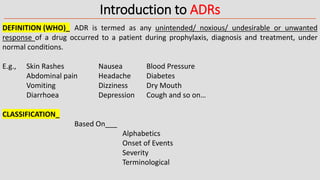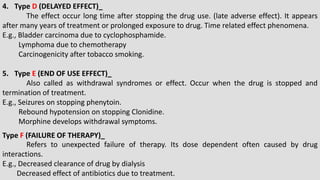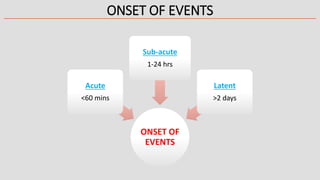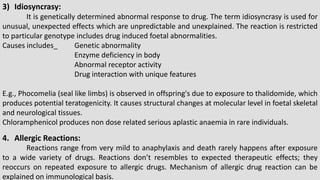Adverse Drug Reactions
- 2. Contentsâ â Introduction & Definition â Common Adverse Drug Reactions â Classification Based on âĒ Alphabetical âĒ Onset of Events âĒ Severity âĒ Terminologies â Multiple Choice Questions
- 3. Introduction to ADRs DEFINITION (WHO)_ ADR is termed as any unintended/ noxious/ undesirable or unwanted response of a drug occurred to a patient during prophylaxis, diagnosis and treatment, under normal conditions. E.g., Skin Rashes Nausea Blood Pressure Abdominal pain Headache Diabetes Vomiting Dizziness Dry Mouth Diarrhoea Depression Cough and so onâĶ CLASSIFICATION_ Based On___ Alphabetics Onset of Events Severity Terminological
- 4. Alphabetical Classification â Augmented Effect â Bizarre Effect â Chronic Effect â Delayed Effect â End of Use Effect â Failure of Therapy 1. Type A (AUGMENTED EFFECT)_ They are dose-dependent; predictable and non-immunologic (75-80%). The effect result from an exaggeration of drugs normal therapeutic response when given at usual therapeutic dose. The reactions are acute and related to mode of action. Some predictable reactions_ Side Effect Toxic effect Intolerances Rebound response after discontinuation E.g., Respiratory depression is observed with opioids overdose. Bleeding with warfarin is seen.
- 5. 2. Type B (BIZARRE EFFECT)_ These are Non-dose dependent, unpredictable and immunological reactions. The reaction arises due to the presence of some peculiarities in patient. The reaction is dependent on patient and not on drug dose. Itâs a common type of reaction. Immediate withdrawal of drug is suggested in case of serious reactions. E.g., Drug allergy: Skin reactions, bronchospasm; vasculitis, etc. Idiosyncrasy: Long term use of oestrogens produce cancer of uterus Photo sensitivity: Reaction due to accumulation of drug in skin absorbing light. Intolerance: Chloroquine causing vomiting and abdominal pain at therapeutic doses. 3. Type C (CHRONIC EFFECT)_ They are dose and time dependent adverse effect on prolonged treatment; continuous as well. These are not pharmacologically predictable, and seen on the basis of drug properties. The chronic reactions are related to drug concentration and are irritant in nature. They results from continuous use of a drug. E.g., Contact dermatitis. Osteoporosis caused due to steroids. Pulmonary fibrosis due to Amiodarone.
- 6. 4. Type D (DELAYED EFFECT)_ The effect occur long time after stopping the drug use. (late adverse effect). It appears after many years of treatment or prolonged exposure to drug. Time related effect phenomena. E.g., Bladder carcinoma due to cyclophosphamide. Lymphoma due to chemotherapy Carcinogenicity after tobacco smoking. 5. Type E (END OF USE EFFECT)_ Also called as withdrawal syndromes or effect. Occur when the drug is stopped and termination of treatment. E.g., Seizures on stopping phenytoin. Rebound hypotension on stopping Clonidine. Morphine develops withdrawal symptoms. Type F (FAILURE OF THERAPY)_ Refers to unexpected failure of therapy. Its dose dependent often caused by drug interactions. E.g., Decreased clearance of drug by dialysis Decreased effect of antibiotics due to treatment.
- 7. ONSET OF EVENTS ONSET OF EVENTS Acute <60 mins Sub-acute 1-24 hrs Latent >2 days
- 8. SEVERITY SEVERITY Minor Mild Therapy, Doesnât affect day to day life Moderate Changes in Drug Therapy & specific treatment Severe Life threatening, Patient needs hospitalization Lethal May lead to the death of patient
- 9. Classification Of ADRs Adverse Drug Reactions are classified as follows_ 1) Excessive therapeutic/ pharmacological effect: It generally appears due to over dose of a drug. This is troublesome with cardioactive hypotensive, hypoglycaemics & CNS depressants. E.g., Hypotensive agent when administered in excess causes profound hypotension. Excessive therapeutic effect may also occur in patients with kidney disease (renal impairment of greater than 70%) hypoalbuminemia; Infants & neonates. In such conditions, dose adjustment is done in order to minimize the adverse reactions. 2) Secondary Pharmacological Effect: The effect produced due to secondary pharmacology of drug, action produced is opposite to the drugs therapeutic action. E.g., Antihistamines are prescribed to allergic reactions but they also produce drowsiness due to its CNS depressant activity simultaneously. This effect is greatly exacerbated if patient is also taking hypnotics, cough suppressants or he/she is alcoholing. Causing Diarrhoea with antibiotic therapy due to altered GITâs bacterial flora.
- 10. 3) Idiosyncrasy: It is genetically determined abnormal response to drug. The term idiosyncrasy is used for unusual, unexpected effects which are unpredictable and unexplained. The reaction is restricted to particular genotype includes drug induced foetal abnormalities. Causes includes_ Genetic abnormality Enzyme deficiency in body Abnormal receptor activity Drug interaction with unique features E.g., Phocomelia (seal like limbs) is observed in offspring's due to exposure to thalidomide, which produces potential teratogenicity. It causes structural changes at molecular level in foetal skeletal and neurological tissues. Chloramphenicol produces non dose related serious aplastic anaemia in rare individuals. 4. Allergic Reactions: Reactions range from very mild to anaphylaxis and death rarely happens after exposure to a wide variety of drugs. Reactions donât resembles to expected therapeutic effects; they reoccurs on repeated exposure to allergic drugs. Mechanism of allergic drug reaction can be explained on immunological basis.
- 11. E.g., Penicillin- anaphylaxis Skin rashes- barbiturates Leucopoenia- sulphonamide 5. Genetically determined toxicity: It occurs in patients with special genotype or genetic makeup causing drug toxicity. E.g., Individuals with deficiency of Glucose 6 phosphate dehydrogenase (G6PD) enzyme involved are at more risk of developing haemolysis after use of antimalarial drugs like Primaquine, etc. 6. Toxicity following drug withdrawal: Tolerance occurs after prolong use of drugs like narcotic, analgesics, hypnotics, ethyl alcohol, some corticosteroids. And on sudden withdrawal of these drugs they show severe adverse effects. E.g., Withdrawal of CNS depressants like alcohol, barbiturates, may produce agitation, tachycardia, confusion, etc. Clonidine on hypertension on its sudden withdrawal cause severe hypertension. Hereditary Conditions Drug causing toxicity Porphyria Barbiturates Pseudocholinesterase Succinyl choline Slow acetylation Isoniazid, Dapsone
- 12. MULTIPLE CHOICE QUESTIONS Q1. Type D is _________ type of Adverse Drug Reaction. a) diverse b) distinct c) dual d) delayed Q2. Occurrence of latent type of ADR- a) >2 days b) <2 days c) up to 4 days d) 24 hours Q3. Phocomelia is a/an __________ type of Reaction. a) Allergic b) Idiosyncratic c) Phototoxic d) All of these Q4. Which of these type is called as withdrawal syndromes/ effect. a) B b) A c) E d) F Q5. __________ADR may cause death of patient a) Lethal b) severe c) minor d) none of these DABCA
- 13. Q6. Phocomelia is observed in offspring's due to exposure to a) sulphonamides b) chloroquine c) tetracycline d) None of these Q7. Generally appears due to over dose of a drug a) Allergic Reaction b) Idiosyncrasy c) Excessive Effect d) Drug withdrawal Q8. ADR is all of the following except a) noxious b) unintended c) desirable d) unwanted Q9. ADR is classified on the basis of a) alphabetics b) severity c) onset of events d) all of these Q10.____________enzyme involved are at more risk of developing haemolysis after use of antimalarial drugs like Primaquine a) CYP450 b) G6PD c) lactose d) None of these Q11. Steven Johnson syndrome is associated with the drug a) Sulphonamides b) Chloramphenicol c) Tetracyclines d) Cephalosporins DCCDBA













